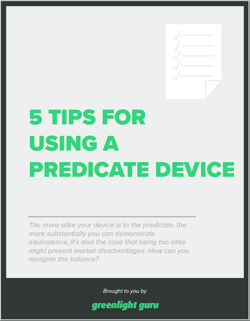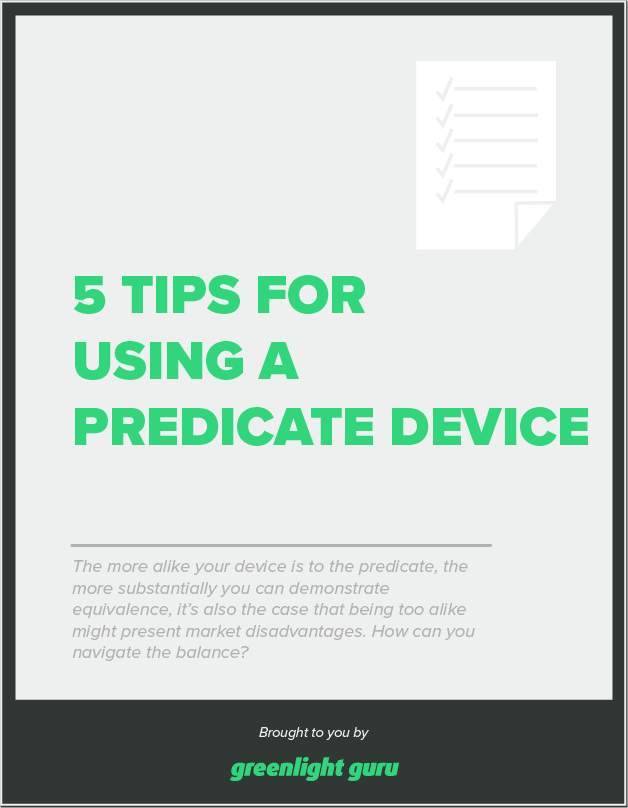Definition
FREE DOWNLOAD: Click here to download our 5 Tips for Using a Predicate Device.
What is a Predicate Device?
When a manufacturer pursues market approval for a new device, FDA wants to reduce the burden for their reviewers while still documenting safety and efficacy. The Medical Device Amendments (MDA) to the Federal Food, Drug, and Cosmetic Act were enacted on May 28, 1976 for this purpose. It allows manufacturers to demonstrate that their new device is substantially equivalent to a device already approved to be legally marketed in the U.S. – a predicate device.
To establish substantial equivalence, the manufacturer must be able to present a strong case proving the device has a similar purpose and is at least as safe and effective as the predicate device. There are two categories of predicate device:
- A Preamendments Device was legally marketed in the U.S. prior to the MDA in 1976. It was grandfathered under the new amendments and did not require a 510(k) submission for the device.
- A Postamendments Device was brought to market after May 28, 1976 via 510(k) submission or premarket approval.
A manufacturer may not choose a predicate device in violation of the FD&C Act, but it does not have to be currently sold and distributed on the market.
How to Choose the Right Predicate Device for a Successful 510(k) Submission
FDA recommends that you choose a predicate device that is most similar to your device with regard to indications for use and technological characteristics. Similarities in the following characteristics help build the case for proving a device is substantially equivalent to a predicate device:
- Intended use
- Design
- Energy used or delivered
- Materials
- Performance
- Safety
- Effectiveness
- Labeling
- And other appropriate considerations
In addition to these criteria, choosing a more recently approved predicate device is preferred due to the rapid changes in technology since 1976. In fact, FDA is considering updating its rules to require that predicate devices be less than ten years old.
The FDA 510(k) database lists all devices cleared through the process, and it is a good starting point in the search for choosing the right predicate device to use. Additional reference devices may be included in the 510(k) submission to support scientific methodology or standard reference values.
Greenlight Guru Eases the Process of Proving Substantial Equivalence with Predicate Devices
A 510(k) submission is a complex process that requires a great deal of organization and attention to detail. The FDA Refuse to Accept Policy outlines the minimum threshold of acceptability for these submissions, but even with this guidance 70 to 75 percent of 510(k) submissions are rejected the first time.
Greenlight Guru’s medical device QMS software includes a built-in advanced document management workflow to create submissions and streamline approvals by maintaining accurate and accessible records for the necessary team members. Using this purpose-built solution makes establishing substantial equivalence to a predicate device easier, getting your product to the patients who need it faster.
FREE DOWNLOAD: Click here to download our 5 Tips for Using a Predicate Device.
Related Links
- Step-by-Step Guide to Preparing your 510(k) Submission
- FDA Modernizing 510(k)
- Abbreviated 510(k)
- 510(k) and Substantial Equivalence
- 510(k) Submission Tips
- What Substantial Equivalence Means for 510(k)
- Common Mistakes with FDA 510(k) Submission
- How to Avoid Rejection of 510(k) Submission
- FDA 510(k) Submission Tips, Tricks, Timelines
- De Novo Pathway Process
Looking for an all-in-one QMS solution to advance the success of your in-market devices and integrates your quality processes with product development efforts? Click here to take a quick tour of Greenlight Guru's Medical Device QMS software →
Get your free PDF
5 Tips for Using a Predicate Device











